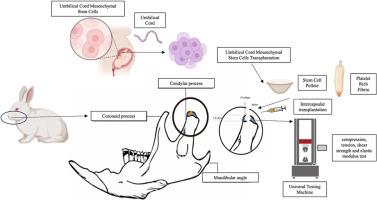Biomechanical analysis of mandibular cartilage defect regeneration after implantation of human umbilical cord mesenchymal stem cells and a platelet rich fibrin scaffold: an experimental animal study
Q1 Medicine
Journal of oral biology and craniofacial research
Pub Date : 2025-09-15
DOI:10.1016/j.jobcr.2025.09.009
引用次数: 0
Abstract
Background
Regenerative medicine is therapy that is expected to be effective for mandibular cartilage defect regeneration. Nevertheless, the biomechanical aspects of mandibular condyle cartilage defect regeneration are still rarely discussed.
Objective
This study aimed too analyze the compression, tensile, shear strength, and elastic modulus in the mandibular condyle cartilage defect regeneration in an animal model after the implantation of human umbilical cord mesenchymal stem cells (hUCMSC) and platelet rich fibrin (PRF) scaffolds. Materials and Methods: The defect were made on 80 New Zealand White Rabbit mandibular condyle cartilages and divided into four groups (three experimental and one control group). The experimental groups consisted of defects treated with implantations of PRF, hUCMSC, and hUCMSC with PRF. Each group consisted of 5 rats, observed for 4-weeks and then euthanized. Compression, tensile, shear strength, and elastic modulus tests were done with Universal Testing Machine. A comparative analysis was performed using SPSS v25 software.
Results
The hUCMSC group had a higher strength of compression (13,462 ± 0,889) MPa with a significant difference (p = 0,000) and tensile strength (2723 ± 0,985) MPa with a significant difference (p = 0,003) than the other groups. The average shear strength and elastic modulus showed that the hUCMSC (1162 ± 0,090 and 8700 ± 1502) and combination groups (0,728 ± 0,071 and 7742 ± 0,814) have significantly higher values than the other groups (p = 0,014 and p = 0,000).
Conclusion
The implantation of hUCMSC results in a high compression and tensile strength of the regenerated defect. The implantation of hUCMSC or hUCMSC seeded on a PRF scaffold is a novel method for mandible cartilage regeneration, and they showed better biomechanics in shear strength and elastic modulus.

人脐带间充质干细胞和富血小板纤维蛋白支架植入后下颌软骨缺损再生的生物力学分析:实验动物研究
背景再生医学是治疗下颌软骨缺损的有效方法。然而,下颌髁突软骨缺损再生的生物力学方面仍然很少被讨论。目的分析人脐带间充质干细胞(hUCMSC)和富血小板纤维蛋白(PRF)支架移植后动物模型下颌髁突软骨缺损再生的压缩、拉伸、剪切强度和弹性模量。材料与方法:80只新西兰大白兔下颌骨髁软骨缺损,分为4组(3个实验组,1个对照组)。实验组由PRF、hUCMSC和hUCMSC联合PRF治疗的缺损组成。每组5只大鼠,观察4周后安乐死。压缩、拉伸、剪切强度和弹性模量试验用万能试验机完成。采用SPSS v25软件进行比较分析。结果hUCMSC组抗压强度(13462±0.889)MPa,差异有统计学意义(p = 0.003);抗拉强度(2723±0.985)MPa,差异有统计学意义(p = 0.003)。平均抗剪强度和弹性模量显示,hUCMSC组(1162±0,090和8700±1502)和组合组(0,728±0,071和7742±0,814)显著高于其他组(p = 0,014和p = 0,014)。结论植入hUCMSC后缺损具有较高的抗压强度和抗拉强度。植入hUCMSC或在PRF支架上植入hUCMSC是一种新的下颌软骨再生方法,它们在剪切强度和弹性模量方面表现出更好的生物力学性能。
本文章由计算机程序翻译,如有差异,请以英文原文为准。
求助全文
约1分钟内获得全文
求助全文
来源期刊

Journal of oral biology and craniofacial research
Medicine-Otorhinolaryngology
CiteScore
4.90
自引率
0.00%
发文量
133
审稿时长
167 days
期刊介绍:
Journal of Oral Biology and Craniofacial Research (JOBCR)is the official journal of the Craniofacial Research Foundation (CRF). The journal aims to provide a common platform for both clinical and translational research and to promote interdisciplinary sciences in craniofacial region. JOBCR publishes content that includes diseases, injuries and defects in the head, neck, face, jaws and the hard and soft tissues of the mouth and jaws and face region; diagnosis and medical management of diseases specific to the orofacial tissues and of oral manifestations of systemic diseases; studies on identifying populations at risk of oral disease or in need of specific care, and comparing regional, environmental, social, and access similarities and differences in dental care between populations; diseases of the mouth and related structures like salivary glands, temporomandibular joints, facial muscles and perioral skin; biomedical engineering, tissue engineering and stem cells. The journal publishes reviews, commentaries, peer-reviewed original research articles, short communication, and case reports.
 求助内容:
求助内容: 应助结果提醒方式:
应助结果提醒方式:


